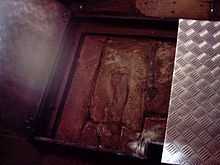Smithills Hall
| Smithills Hall | |||||||||||||||||||||||||||||||
|---|---|---|---|---|---|---|---|---|---|---|---|---|---|---|---|---|---|---|---|---|---|---|---|---|---|---|---|---|---|---|---|
 Smithills Hall Chapel and east range.
| |||||||||||||||||||||||||||||||
| |||||||||||||||||||||||||||||||
Smithills Hall is a Grade I listed manor house,[1] and a scheduled monument[2] in the township of Halliwell, Bolton, Greater Manchester, England. it stands on the slopes of the moors above Bolton at a height of 500 feet, two miles north west of the town centre. It occupies a defensive site near the Astley and Raveden Brooks. One of the oldest manor houses in the north west of England, its oldest parts, including the great hall, date from the 15th century and it has been since been altered and extended particularly the west part. Parts of it were moated.[3] The property is owned by Bolton Metropolitan Borough Council and open to the public.
History
The name Smithills derives from the Old English smeþe meaning smooth and hyll, a hill and was recorded as Smythell in 1322.[4] Early medieval records about the hall began in 1335 when William Radcliffe acquired the manor from the Hultons who held it from the Knights Hospitaller. On Radcliffe's death in 1369 it passed to his son and heir Sir Ralph Radcliffe, High Sheriff of Lancashire for 1384–1387 and twice MP for Lancashire. The Radciffes lived there until 1485, when the male line failed and Smithills Hall passed to the Bartons, wealthy sheep farmers who lived there for nearly 200 years.
In 1659 the hall and estate passed by marriage to the Belasyse family. In 1722 the Byroms of Manchester bought the manor and kept it until 1801 when the hall and estate were acquired by the Ainsworths, who made their fortune as the owners of bleachworks at Barrow Bridge.[3] Around 1875 Richard Henry Ainsworth employed architect George Devey to extend and modernise the hall. In 1938, George Ainsworth sold the hall to Bolton Corporation. Parts of it became a residential home and day centre that closed in the 1990s.
The oldest parts of the hall opened as a museum in 1963, and in the 1990s, the museum was extended into some of the Victorian extensions. The west wing was restored by the council in 1999.
In 1554 George Marsh a preacher from Deane near Bolton was 'examined' at Smithills Hall, before being sent to Chester to be tried for heresy. He was found guilty and executed at Boughton in Chester. A footprint, supposedly left by Marsh, is said to bleed every year on the anniversary of his death (24 April).[5]


Nathaniel Hawthorne visited and described the hall when he was United States consul in Liverpool in 1855.[3]
Architecture
Smithills Hall is on a formal terrace, surrounded on all sides by parkland on the south side of a steep-sided valley formed a tributary if the Raveden Brook.[6]
Smithills Hall has three ranges around an open court. The oldest part of the structure is the great hall in the north range which was probably built in the early 14th century and once had a moat. It has been altered but retains its original plan and medieval features.[3] The oldest parts were built with timber frames and the oldest stonework is roughly coursed rubblestone. The 19th century west wing is built in coursed, squared stone and has decorative timber framing. All the roofs are covered in stone flags.[2]
Park and gardens
The 48-hectare (120-acre) gardens and pleasure grounds are on south facing sloping land on the edge of moorland with a steep wooded valley and lake to the north and formal gardens around the hall.[6]
Television
Smithills Hall appeared on the British television series Most Haunted in 2005 episode #85 and in the second series (episode 8) of Great British Ghosts.
See also
- Grade I listed buildings in Greater Manchester
- Petrosomatoglyph
- Scheduled Monuments in Greater Manchester
References
Notes
- ↑ English Heritage, "Smithills Hall, Smithills Dean Road (1388279)", National Heritage List for England, retrieved 13 May 2013.
- ↑ 2.0 2.1 Smithills Hall (43437), PastScape, English Heritage, retrieved 13 May 2013
- ↑ 3.0 3.1 3.2 3.3 Farrer, William; Brownbill, J., eds. (1911), "Halliwell", A History of the County of Lancaster: Volume 5 (British History Online): 12–20
- ↑ Mills 1976, p. 134
- ↑ Wilkes, Sue. "Smithills Hall, Bolton - BBC History Magazine". BBC History Magazine. Retrieved 5 August 2013.
- ↑ 6.0 6.1 English Heritage, "Smithills Hall, Bolton (1001442)", National Heritage List for England, retrieved 13 May 2013.
Bibliography
- Mills, David (1976), The Placenames of Lancashire, Batsford, ISBN 0-7134-5236-6
External links
| Wikimedia Commons has media related to Smithills Hall. |
- History and photographs
- Tourist details from visitmanchester.com
- Smithills Hall, Bolton BBC History Magazine
| ||||||||||||||||||||||||||
